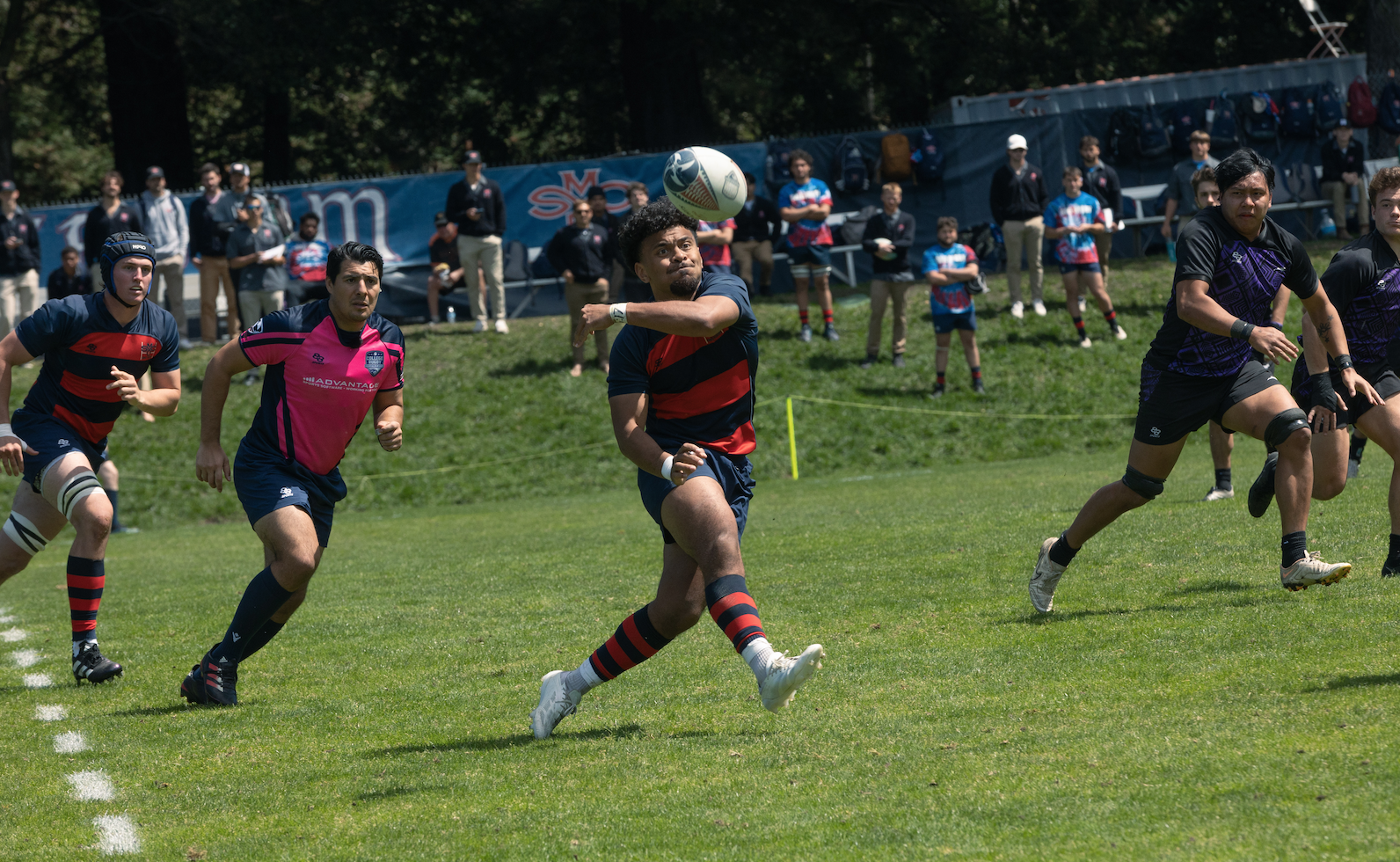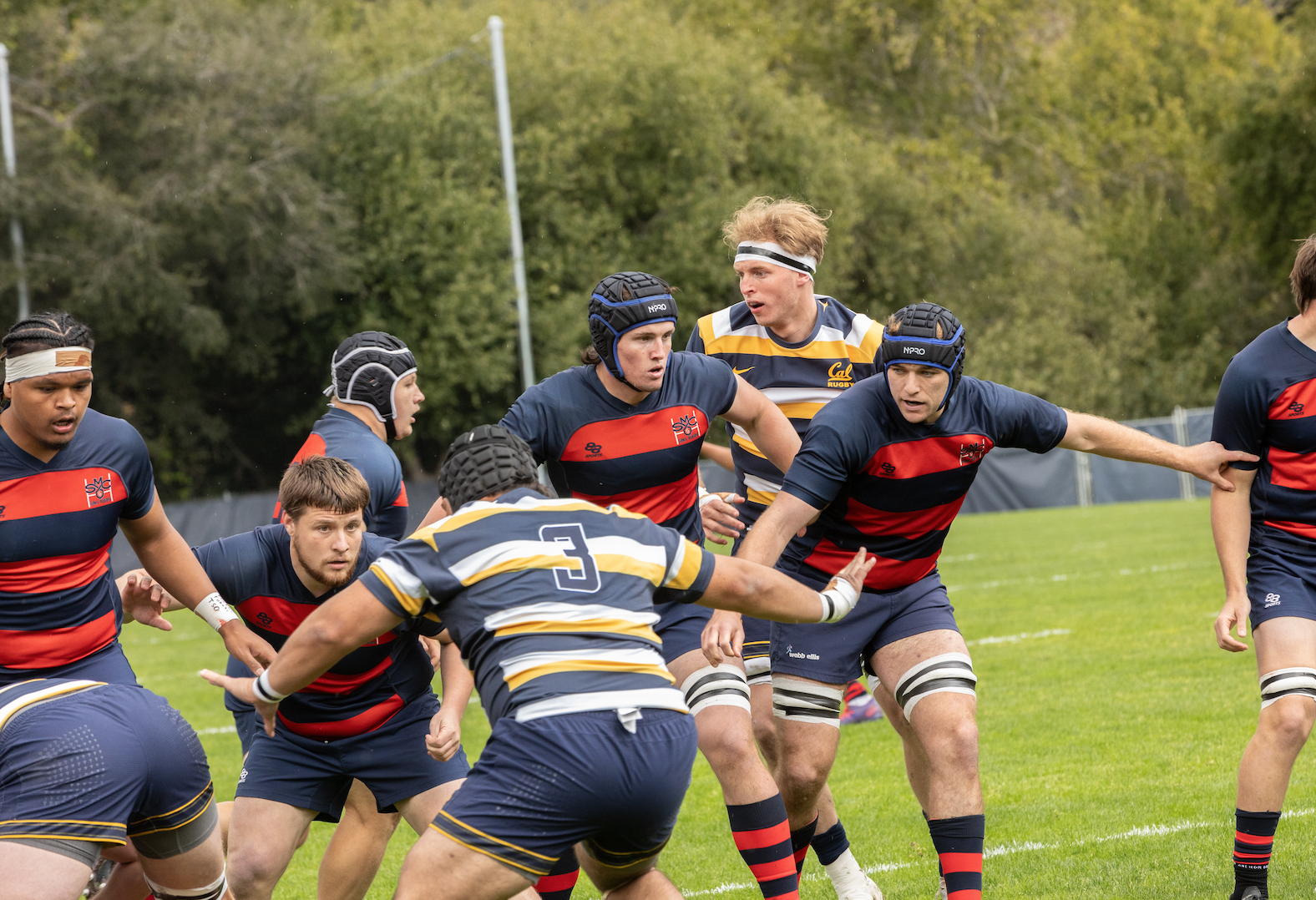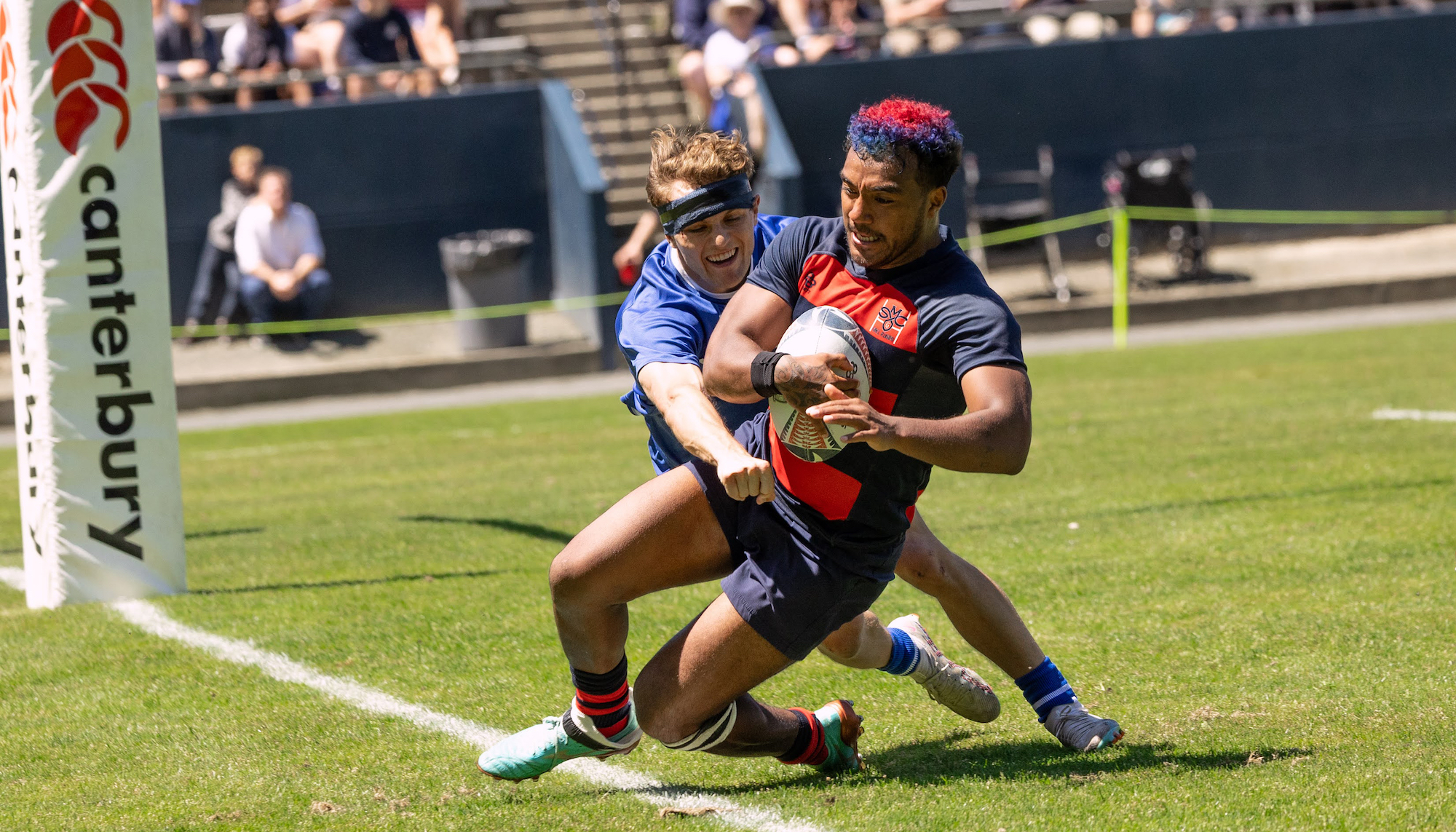
Juice on the field: Team Captain Kaipono Kayoshi ’23, MA ’24 scores against BYU to help propel the Gaels into the National Championship on May 4. Kayoshi is part of the “three-headed dragon” of players who lead the team. / Photo by Rebecca Harper
Here’s What the Gaels Are Bringing to the Rugby National Championship
On May 4, when Saint Mary’s takes to the pitch in Houston to face Navy, keep your eyes out for a three-headed dragon on the field—and a team fueled by “juice, joy, and accuracy.”
Texas, here come the Gaels: Saint Mary’s Men’s Rugby heads for Houston for the Division 1A Rugby National Championships. On Saturday, May 4, they square off against Navy in SaberCats Stadium.
For the opening kickoff at 7 p.m. Central—5 p.m. for those cheering on the team from California—expect the air to be sultry: temp around 80ish, humidity 70 percent, give or take. After all, it’s Houston. And expect the atmosphere in the stadium to be electric, as two rugby powerhouses engage in this combat sport to claim the national cup.
This is the seventh trip the Gaels have made to the national championship since 2013 under Coach Tim O’Brien. They’ve won it three times—in 2014, 2015, and 2017—and won the national championship for rugby sevens in 2016.
There will be 15 men on the field in Saint Mary’s red-and-blue jerseys for the opening kickoff. Look for 10 more Gaels suited up on the sidelines. But, as the captains of the team will tell you, this team is 60 men deep. That’s how it’s been all season long—on game days and on excruciating hill runs in Moraga like those in the lead up to the championship match.
“Our bench, whether they’re suited up or not, they just bring the noise,” says Team Captain Kaipono Kayoshi ’23, MA ’24. “They bring the juice every game day, and when stuff’s not going as good as we hope, they’ll just lift us up.”
Kayoshi is known by his teammates as Pono. He’s part of the “three-headed dragon” of team leadership, along with Inoke Waqavesi Jr. ’23, MA ’24 and Erich Storti ’23, MBA ’24. As the Gaels prepare to take on defending national champs Navy, I sat down with the three of them to talk about what makes Gaels rugby tick and what this game means to them.
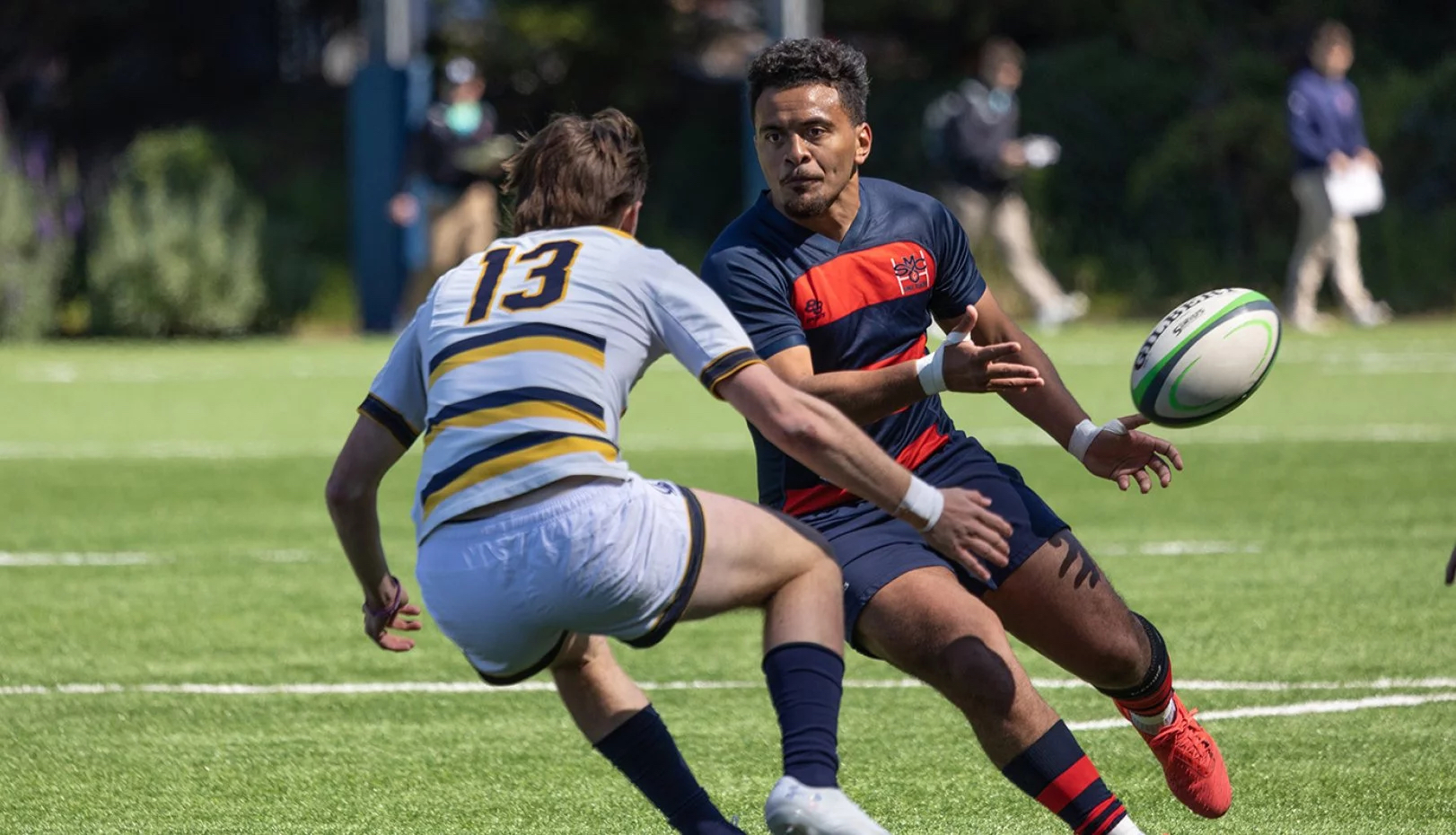
Meet the Three-Headed Dragon
First, a little about the three-headed dragon. It’s a moniker bestowed upon that trio by Coach O’Brien, who is quick to say that if you want to understand what Gaels rugby is really all about, the players are the ones you should talk to.
Inoke Waqavesi Jr., whom his teammates know as Junior on the pitch, grew up in the Sacramento area and has been playing rugby since age 10. “It's a big sport in Sacramento, especially with the Pacific Islander community,” he says. His parents are Fijian, his mother half Tongan. He was good enough at the game in high school that he played with the EIRA Team—that would be Eagle Impact Rugby Academy, a development program for the US National Team—and traveled internationally. Talking with O’Brien, and looking at the education he could get at Saint Mary’s, sold him on the program. As a Moonlight Scholar at SMC, he earned a bachelor’s in Sports Management and is now working on his master’s.
Erich Storti hails from Concord, just up the road, and went to De La Salle High School. His father, Marty Storti ’85, MA ’89, played football, baseball, and rugby at Saint Mary’s—and went on to coach the rugby team for about 15 years. “I’ve had that connection to Saint Mary's my entire life,” Erich says. At SMC he earned a BS in Economics with a minor in Data Science, and he’s currently enrolled in the Professional MBA Program. He had the rugby connection for years, too, but he didn’t start playing until high school; his younger brother, rugby teammate Mario Storti ’25, actually started playing in junior high.
Kaipono Kayoshi also came to rugby as something of a late bloomer; he didn’t start playing until age 15 or so, in the Granite Bay area near Sacramento. His family is Hawaiian, and after a couple years he found his groove in the rugby scene. “I played against Junior all my high school career,” he says. “I was the guy who would mark him up. It was like Deion Sanders and Jerry Rice.”
Inoke laughs when Pono says this. But he doesn’t dispute it.
Pono also played on the EIRA Team with Inoke. And he confesses to not having been an exactly stellar student in high school. It was his twin sister, Kanami Kayoshi ’22, who put Saint Mary’s on his radar. He talked with Marty Storti about how, if given a chance at SMC, he had the academic chops to succeed and knew how to apply himself.
And, as he has shown, he could build the leadership skills to help take a team to the national championship.
“Pono kind of cracks the whip, and he does all the barking—and I make sure all the boys are in line,” Inoke says. “We back him 100% because he's been here, he’s the most experienced, and he’s put in the work, has the accolades to show for it. We trust him.”
“Pono is fearless,” Erich Storti says of Team Captain Kaipono Kayoshi. “He’s easy to rally behind. He's not just going to tell you to do something.”
“Pono is fearless,” Storti says. “He’s easy to rally behind. He's not just going to tell you to do something. And Junior, his emotional IQ is really impressive. In the huddle, when you hear Junior talk, you’re gonna listen. He does a really good job of banding boys together. And if one of us is having a bad day, we'll pick each other up.”
“We’re also honest with each other,” Pono says. He recounts Erich coming up to him after one match and telling him, “‘Pono, you didn’t have your best game. We need more out of you.’” It was the kind of blunt honesty real friends and committed teammates can share.
“Junior, he’s just as consistent as they come,” Pono says. “He’s gonna lead by example with his play. Erich, he's Mr. Perfect—I'd put him against the best player. He’s someone who’s absolutely dependable.”
“Erich is sort of like the glue,” Inoke says. “You'll get a lot of emotions out of me and Pono, but with Erich, you get a calm voice. And he's able to see different aspects of the game—more gameplay attack or strategy. He's able to pick apart teams. Playing with him is much better than playing against him!”
Indeed, this year Storti was one of two Gaels nominated for the Rudy Scholz Award, honoring the top collegiate rugby player in the country. The other is Dominic Besag ’26, who’s a finalist for the award. The winner will be announced in June.

Juice, Joy, and Accuracy
What fuels Gaels rugby? “We’re pretty expansive in our play,” Inoke says. “We’re a real attacking team. We love to move the ball.” And, he says, “There are three elements of our game: juice, joy, and accuracy. It’s our winning equation.”
What exactly do they mean by that? “Juice is the amount of intensity and excitement that we play with—a defensive mindset. Joy is an offensive mindset where we have fun, because we really do. And in everything we do, we want to tie it together with accuracy. That’s us in a nutshell.”
Inoke also cites the role that sports psychologist Bo Hanson has played in helping nurture the program. A three-time Olympic medal-winner with the Australian rowing team, Hanson was brought in by Coach O’Brien to work with the team to help them define and adhere to a winning culture. “Our winning equation is very important,” Inoke says. “And there’s three of us leading the team. I think we kind of exemplify those three traits quite well. My take is Pono is the juice part. Eric is the accuracy. And I’m the joy.”
“Ask any alumni, they’ll tell you the same thing: The culture of our program is that we’ve always wanted to leave the program better than we found it.”
—Inoke Waqevesi Jr.
There’s also an underdog mentality to Gaels rugby. Their arch rival in the Bay Area is UC Berkeley, with a student body ten times the size of Saint Mary’s. And at SMC, Men’s Rugby is a Club Sport, thriving thanks to tremendous support from generations of alumni. Being a Club Sport also means, Inoke explains, “We don't turn anybody away. We get kids from different experience levels from just starting the first day they show up to those who have been playing their whole life. If you want to be part of this team, this is the work that you have to put in.”
“Shared suffering” is how Storti puts it when it comes to the training.
“Testament to Tim’s coaching, he's made a lot of men out of boys,” Inoke says. “And ask any alumni, they’ll tell you the same thing: The culture of our program is that we've always wanted to leave the program better than we found it.”
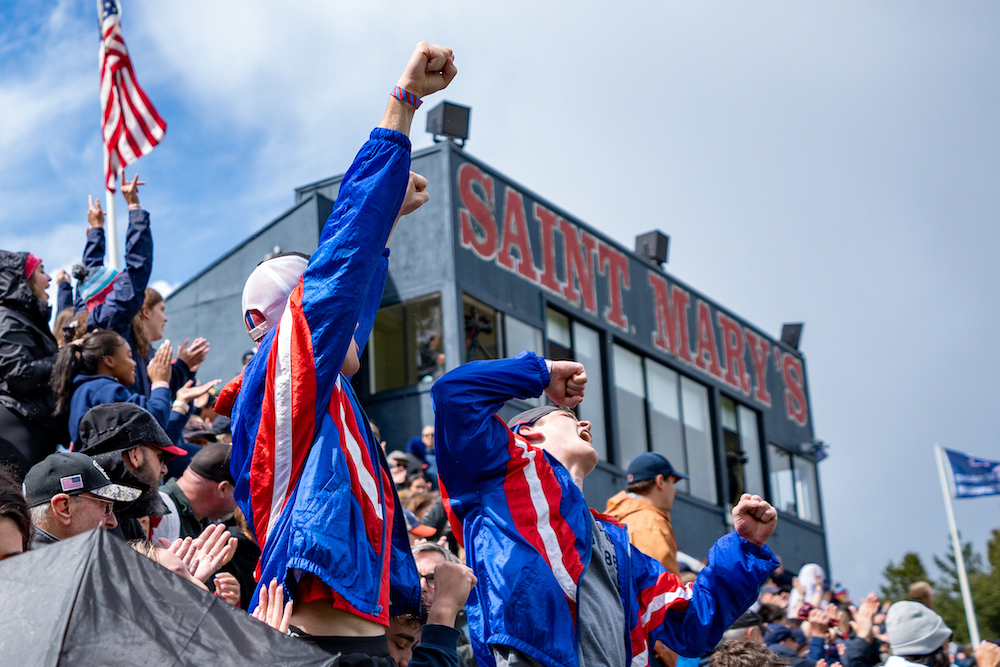
Game Day
On home game days, the team comes into the Joseph L. Alioto Recreation Center in the morning for warmups and taping, then a classroom session to set goals for the day. Then it’s out on the field for extended warmups and under the posts for the national anthem. Everything is team-led, with O’Brien playing a key role in the classroom. “That's how he gives us leeway to prepare the boys mentally and physically for the game,” Inoke says.
For the national championship, the routine may be a little different. But there is one constant ritual—for practice and games alike—whether in the regular season or the playoffs of the championship: “We breathe together,” says Storti. “We all link up one deep, and Pono usually gets us three breaths. It’s our connecting activity, in a way. No one’s talking. We’re all focused.” And that’s not only for the beginning of games. “Whenever we get scored on, we’re under the posts, we’re getting our breaths, we’re resetting, refreshing.”
The team also recently started to have dinners together on Fridays—a tradition they revived from former Gaels captain Kevin O’Connor ’17, who has multiple national championships under his belt. “We bring all types of food and just chop it up,” Pono says. It’s a good way to spend time together and bond.
When it comes to personal rituals, Pono has a food-related one of his own. “I have to eat a cup of Jello at halftime,” he says. “Strawberry. I don’t know how that started.”
There’s another ritual that has very clear beginnings: the brilliant blue and red Pono has dyed his hair. He laughs sheepishly when he tells the story. Spin back the calendar a few years to a game against Cal: always a tough match, with Saint Mary’s coming up on the losing end frustratingly often. “What’s gonna be different?” Pono wondered. “And I was like, ‘We should dye our hair.’” Half a dozen or so of the players were game. “I also told them, ‘We gotta win, though, because we’re gonna look stupid if we don’t.’ We came out and Tim looked at us like, What the hell? But all he said was, ‘You better win.’ We played Cal on Pat Vincent Field. And we won. Ever since then, I've been dyeing my hair for Cal games. This year, the boys really bought in and dyed their hair. And we beat Cal.”
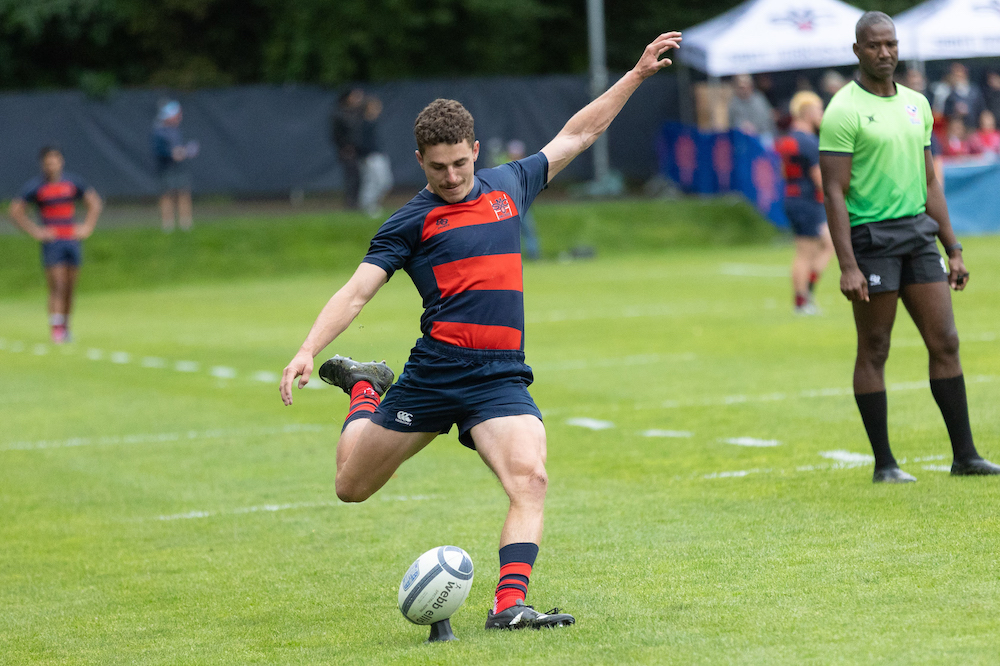
Indeed, Saint Mary’s defeated Cal in the quarter finals after besting them in the regular season as well. That was a big deal. Last year, the Gaels’ season came to a close when Cal scored on the last play of the quarter finals. That was tough. And it was a deja vu moment for Pono; in the 2018–19 season, the Gaels also lost to Cal on the last play.
In between were the COVID years. Saint Mary’s had a strong squad, but the pandemic short-circuited their hopes. In 2022, the Gaels made it to the national championship match but suffered a heart-wrenching 20–8 loss to Army.
“When we played Army, we felt like we didn't execute well,” Storti says. “We made our own mistakes. So we really want to execute—whether it's our game plan or micro skills, and focus on doing the best we can in each and every opportunity that comes.”
All of which is also to say that this is a team ready to win it all. But they’re also doing so one game at a time. In fact, they were so focused on beating BYU in the semifinals—we need to do this better—that Pono, Inoke, and Storti only realized hours after the match that this was the last time they would be putting on the jersey for a home game.
“We forgot to take a picture!” Inoke says.
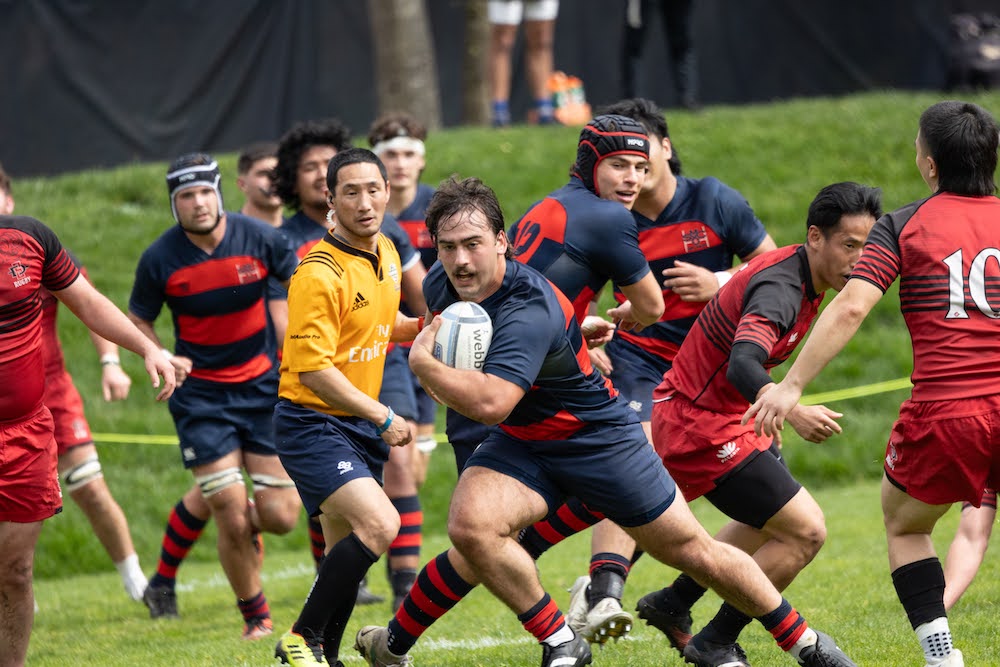
“Something that we do together.”
If you were to take a picture of who got this team to where they are, naturally that would include the whole 60-man roster, with those not suited up for play that day there in their Gaels warm-up tie-dyes. There are the coaches—along with Tim O’Brien, that would be Mark Bass and Andrew Cook ’12, who have shaped the rugby culture for years. All three have full-time day jobs, from institutional securities sales trader to project manager to sales manager, so the tremendous time they give is on top of that. It’s weekends, evenings, and road trips, the players underscore, that the coaches’ families—including spouses Chris O’Brien, Sharon Bass, and Alyssa Cook—graciously let them devote to the team. “Their families are so supportive, and they understand how much those coaches mean to us,” Storti says.
There are the former coaches who have built the program. There are generations of alumni who have given advice and treasure and moral support. Parents who have laid out spreads to feed ravenous players at home or on the road. Staff with SMC Club Sports who work with hundreds of athletes, including Rebecca Harper, who directs Campus Recreation and Club Sports (and whose skills behind the camera bring so many great action shots from games), as well as strength coach Volney Rouse ’07—who was also MVP of the first iteration of the professional rugby league, playing for the San Francisco Rush. Trainer Amanda Morton works with the team and Club student-athletes throughout SMC. And for nearly two decades, Betsy Abel has worked with Men’s Rugby as a massage therapist.
“It's a shared collaborative effort,” Inoke says. “It's something that we do together. The victory will come and we'll win together.”

Chaos and Calmness
Another thing about Coach O’Brien, Pono says: “Tim does a great job at making us not too complacent. We focus on what we can do better instead of hanging on hats on the highs. Talk to any Saint Mary's player, and he’d tell you the negatives before the positives.”
With days still to go before the team flies to Houston, there’s plenty of time left to practice. “A lot of his game plans for practice schedules are tailored to make practices harder than the games,” Inoke says. “So when we do get into those situations of high-pressure moments, we're able to feel a sense of calmness—because we've already been through it with practice.”
Pono nods at that. “During practice, he loves to create chaos, massive chaos—and we’ll be thinking, This is never gonna happen during the game. Then sure enough, it happens during the game. And we're prepared for it—like during the Cal game. The difference is, we don't have him yelling at us! So we're like, Oh, this is easy.”
During practice, Coach O’Brien loves to create chaos, says Kaipono Kayoshi. “Massive chaos—and we’ll be thinking, This is never gonna happen during the game. Then sure enough, it happens during the game. And we're prepared for it.”
What is definitely not easy is when every few years O’Brien brings Remi Adaleke, a former Navy SEAL, to put the team through an intense stretch of training to figure out how to be better, together. “That was tough,” Inoke says. “They put us through submarine training—we're all jumping in the pool, fully clothed, getting back out, bear crawling to the front field from the pool. It's a lot of tough, gritty work that kind of challenges us both mentally and physically, but allows us to understand that the only way that we'll get to the next level is with each other.”
Given the roles the three captains are playing now, Storti points to the success O’Brien has achieved in developing a leadership program for the team. “He says it's a player-run team, and he's not going to take credit for anything, but he empowers people so that they're able to have a big impact. It's really effective. It creates a culture where people feel like they're contributing.”
Pono also admires that O’Brien stays curious about the game—and that early on he insisted that Pono push back if he disagreed on strategy and game plans. “He's still a student of the game. And he makes us see a new way of thinking.”
Conversations with alumni from across the years have also taught the current team that O’Brien’s own coaching style has evolved over the years. “He's been able to grow with the game,” Inoke says. “He always says rugby is a problem-solving activity. And different problems arise that he's never seen before, year after year.”
But it’s not just on the field where the lessons have taken root. “As young men, I think he’s instilled in us skills that we'll be able to take into our professional lives, and especially in our families, as well,” Inoke says.

Preparing for the Championship
In going up against Navy, the Gaels have a pretty good sense of what’s in store. “We know that they like to kick a lot,” Inoke says. “They’re a big, physical team. They’d much rather defend than play with ball in hand. So we’ll look to be prepared to return their kicks and just really sharpen up our attack.”
One thing that’s different for this year’s championship: Both teams have an extra week to rest and prepare, versus a tighter, more exhausting turnaround from playoffs to championship in 2022.
Pono, Inoke, and Storti all played in that match. This time, facing another branch of the military, they’re even more hungry to win it. “The younger guys, they want it as much as we do, which is kind of rare,” Pono says. “The young guys are pushing older guys too. We’ll have some off days. Then we got guys like Dom Besag ’26 and he's living the winning equation with juice, joy, and accuracy. We got those guys to fall back on. And together, we just focus on our purpose.”
They’re thrilled to be returning to Sabercats stadium—a fantastic venue, Storti says. “It definitely is a beautiful rugby pitch to play on,” Inoke concurs. “Though I wouldn't take it over my stadium at home.”
Houston is home turf these days for Ronan Murphy ’20, who plays Major League Rugby with the Sabercats. Also in Texas is Ronnie McElligot ’22, playing with the Dallas Jackals. Back on the West Coast is Tavite Lopeti ’21 with the Seattle Seawolves, who has also played with the US Eagles National Team.
“Tavite has actually been training with us,” Storti says. “We have a mentorship program full of alumni. They’re guiding us in our professional world, too.”
But first things first: “Alright, we got Navy,” Pono says. “We just focus on what's next. Because the job’s not finished by any means.”
This is the last year of college rugby eligibility for the trio. Their last match will be playing for the national championship. Inoke speaks for all three of them when he says, “I wouldn’t want it any other way.”
Steven Boyd Saum is Executive Director of Strategic Communications & Content at Saint Mary's. Write him.
Story updated to include new kickoff time on April 30 at 9:30 a.m. Pacific.



